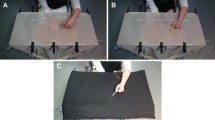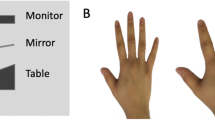Abstract
The brain needs information about the size of the body to control our interactions with the environment. No receptor signals this information directly; the brain must determine body size from multiple sensory inputs and then store this information. This process is poorly understood, but somatosensory information is thought to play a role. In particular, anaesthetising a body part has been reported to make it feel bigger. Here, we report the first study to measure whether changes in body size following anaesthesia are uniform across dimensions (e.g. width and length). We blocked the digital nerves of ten human subjects with a clinical dose of local anaesthetic (1 % lignocaine) and again in separate sessions with a weaker dose (0.25 % lignocaine) and a saline control. Subjects reported the perceived size of their index finger by selecting templates from a set that varied in size and aspect ratio. We also measured changes in sensory signals that might contribute to the anaesthetic-induced changes using quantitative sensory testing. Subjects perceived their finger to be up to 32 % wider during anaesthesia when compared to during a saline control condition. However, changes in perceived length of the finger were much smaller (<5 %). Previous studies have shown a change in perceived body size with anaesthesia, but have assumed that the aspect ratio is preserved. Our data show that this is not the case. We suggest that nonuniform changes in perceived body size might be due to the brain increasing the body’s perimeter to protect it from further injury.





Similar content being viewed by others
References
Alloway KD, Rosenthal P, Burton H (1989) Quantitative measurements of receptive field changes during antagonism of GABAergic transmission in primary somatosensory cortex of cats. Exp Brain Res 78:514–532
Blanke O, Arzy S (2005) The out-of-body experience: disturbed self-processing at the temporo-parietal junction. Neuroscientist 11:16–24
Botvinick M, Cohen J (1998) Rubber hands ‘feel’ touch that eyes see. Nature 391:756
Calford MB, Tweedale R (1991) Acute changes in cutaneous receptive fields in primary somatosensory cortex after digit denervation in adult flying fox. J Neurophysiol 65:178–187
Cardinal RN, Aitken MRF (2006) ANOVA for the behavioural sciences researcher. Lawrence Erlbaum Associates, New Jersey
Catterall W, Mackie K (1996) Local anesthetics. In: Hardman JGG, Gilman A, Limbird LL (eds) Goodman and Gilman’s the pharmalogical basis of therapeutics, 9th edn. McGraw Hill, New York, pp 331–347
Dykes RW, Craig AD (1998) Control of size and excitability of mechanosensory receptive fields in dorsal column nuclei by homolateral dorsal horn neurons. J Neurophysiol 80:120–129
Dykes RW, Lamour Y (1988) An electrophysiological laminar analysis of single somatosensory neurons in partially deafferented rat hindlimb granular cortex subsequent to transection of the sciatic nerve. Brain Res 449:1–17
Ehrsson HH, Holmes NP, Passingham RE (2005) Touching a rubber hand: feeling of body ownership is associated with activity in multisensory brain areas. J Neurosci 25:10564–10573
Franchak JM, Adolph KE (2014) Gut estimates: pregnant women adapt to changing possibilities for squeezing through doorways. Atten Percept Psychophys 76:460–472
Freund H (2003) Somatosensory and motor disturbances in patients with parietal lobe lesions. Adv Neurol 93:179–193
Fuentes CT, Longo MR, Haggard P (2013) Body image distortions in healthy adults. Acta Psychol 144:344–351
Gandevia SC, Phegan CML (1999) Perceptual distortions of the human body image produced by local anaesthesia, pain and cutaneous stimulation. J Physiol 514:609–616
Gandevia SC, Smith JL, Crawford M, Proske U, Taylor JL (2006) Motor commands contribute to human position sense. J Physiol 571:703–710
Gasser HS, Erlanger J (1929) The role of fiber size in the establishment of a nerve block by pressure or cocaine. Am J Physiol 88:581–591
Inui N, Walsh LD, Taylor JL, Gandevia SC (2011) Dynamic changes in the perceived posture of the hand during ischaemic anaesthesia of the arm. J Physiol 589:5775–5784
Ishak S, Franchak JM, Adolph KE (2014) Perception-action development from infants to adults: perceiving affordances for reaching through openings. J Exp Child Psychol 117:92–105
Jeannerod M (1981) Intersegmental coordination during reaching and natural visual objects. In: Long J, Baddeley A (eds) Attention and performance IX. Lawrence Erlbaum, Hillsdale, pp 153–168
Jeannerod M, Michel F, Prablanc C (1984) The control of hand movements in a case of hemianaesthesia following a parietal lesion. Brain 107:899–920
Lewis JW (2006) Cortical networks related to human use of tools. Neuroscientist 12:211–231
Longo MR, Haggard P (2010) An implicit body representation underlying human position sense. Proc Natl Acad Sci USA 107:11727–11732
Mon-Williams M, Bingham GP (2007) Calibrating reach distance to visual targets. J Exp Psychol Human 33:645–656
Paqueron X, Leguen M, Rosenthal D, Coriat P, Willer JC, Danziger N (2003) The phenomenology of body image distortions induced by regional anaesthesia. Brain 126:702–712
Paqueron X, Gentili ME, Willer JC, Coriat P, Riou B (2004a) Time sequence of sensory changes after upper extremity block: swelling sensation is an early and accurate predictor of success. Anesthesiology 101:162–168
Paqueron X, Leguen M, Gentili ME, Riou B, Coriat P, Willer JC (2004b) Influence of sensory and proprioceptive impairment on the development of phantom limb syndrome during regional anesthesia. Anesthesiology 100:979–986
Proske U, Gandevia SC (2012) The proprioceptive senses: their roles in signalling body shape, body position and movement and muscle force. Physiol Rev 92:1651–1697
Schady W, Braune S, Watson S, Torebjörk HE, Schmidt R (1994) Responsiveness of the somatosensory system after nerve injury and amputation in the human hand. Ann Neurol 36:68–75
Schwoebel J, Coslett HB (2005) Evidence for multiple, distinct representations of the human body. J Cogn Neurosci 17:543–553
Tanner JM (1962) Growth at adolescence, 2nd edn. Blackwell Scientific Publications, Oxford
Tsakiris M, Hesse MD, Boy C, Haggard P, Fink GR (2007) Neural signatures of body ownership: a sensory network for bodily self-consciousness. Cereb Cortex 17:2235–2244
Visser J, Geuze RH, Kalverboer AF (1998) The relationship between physical growth, the level of activity and the development of motor skills in adolescence: differences between children with DCD and controls. Hum Mov Sci 17:573–608
Walsh LD, Gandevia SC, Taylor JL (2010) Illusory movements of a phantom hand grade with the duration and magnitude of motor commands. J Physiol 588:1269–1280
Walsh LD, Moseley GL, Taylor JL, Gandevia SC (2011a) Proprioceptive signals contribute to the sense of body ownership. J Physiol 589:3009–3021
Walsh LD, Taylor JL, Gandevia SC (2011b) Overestimation of force during matching of externally generated forces. J Physiol 589:547–557
Wing AM, Fraser C (1983) The contribution of the thumb to reaching movements. Q J Exp Psychol A 35:297–309
Acknowledgments
This work was funded by the National Health and Medical Research Council (of Australia), the EU FP7 Project VERE Work Package 1 and the European Research Council Advanced Grant HUMVOL.
Conflict of interest
The authors declare that they have no conflict of interest.
Ethical standard
All procedures performed in studies involving human participants were in accordance with the ethical standards of the institutional and/or national research committee and with the 1964 Helsinki declaration and its later amendments or comparable ethical standards.
Informed consent
Informed consent was obtained from all individual participants included in the study.
Author information
Authors and Affiliations
Corresponding author
Rights and permissions
About this article
Cite this article
Walsh, L.D., Hoad, D., Rothwell, J.C. et al. Anaesthesia changes perceived finger width but not finger length. Exp Brain Res 233, 1761–1771 (2015). https://doi.org/10.1007/s00221-015-4249-1
Received:
Accepted:
Published:
Issue Date:
DOI: https://doi.org/10.1007/s00221-015-4249-1




